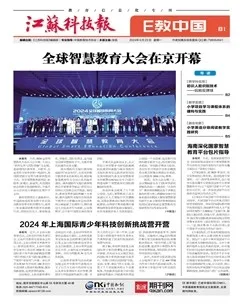译题:教育中的生成式人工智能
2024-12-31
Generative AI in education:Educator and expert views (Ⅱ)
Product by The Open Innovation Team and Department for Education" 英国政府开放创新团队及英国教育部
Detailed findings
The education sector is acknowledging the need to adapt to GenAI technology.
Advances in AI are likely to have a profound and widespread effect on the UK economy and society. Education is one of the top sectors expected to be impacted by AI and GenAI, alongside industries like banking, research shows. In addition to augmenting educator jobs and tasks, GenAI could also fundamentally alter how and what people learn by changing how information is synthesised and presented.
Experts and educators acknowledge GenAI’s potential to benefit education, such as by acting as a tool to support teachers with their workload and enable self-directed and personalised learning for students. There is also a strong sense GenAI could profoundly disrupt the sector, including by changing what students need to learn to prepare them to enter an AI-enabled workforce.
Adoption of GenAI among teachers has rapidly increased, with two in five teachers now having used GenAI in their role.
According to a survey from Teacher Tapp in November, 42% of primary and secondary teachers have now used GenAI to help them with schoolwork. This has increased from 35% in August and 17% in April. In comparison to the wider public, around a quarter of the UK consumers (aged 16-75) had used a GenAI tool in June 2023.
There was significant variation in the frequency of use among the educators interviewed. Some reported using GenAI tools daily, and that use was widespread among colleagues. Others had only used GenAI a few times and were not aware of colleagues using it.
Educators who are men, younger and those in secondary schools are more likely to be using GenAI.
DfE’s survey of school and college teachers (conducted in April 2023) showed that those who were more likely to have used GenAI were:
?誗 Working in secondary schools: 14% of secondary school teachers compared to 9% in primary schools. 23% of college educators had used GenAI.
?誗 Male: 18% of teachers who are men compared to 9% of teachers who are women.
?誗 Younger: 15% of teachers aged 18-34 had used GenAI compared to 9% of those aged 45-54.
This aligns with trends in awareness of GenAI among the UK public:
?誗Men: 60% of men had heard of GenAI compared to 46% of women.
?誗Young people: 73% of under 35s had heard of GenAI compared to 27% of 65-75s.
Pupils and students may be using GenAI more than educators.
Ofcom reports that 74% percent of online 16-24-year-olds in the UK have used a GenAI tool. Among younger children use is similarly high, with 79% of online teenagers (aged 13-17) and 40% of online 7-12-year-olds reporting that they had used ChatGPT, Snapchat My AI,Midjourney or DALL-E. The most commonly used GenAI tool among children is Snapchat My AI.
DfE’s survey of secondary school pupils showed 14% using AI tools for schoolwork . However, other surveys show figures of 67% of secondary school pupils using GenAI tools for schoolwork and around half of HE students using ChatGPT to support their studies.
Parents lack clarity on their children’s use of AI tools. DfE’s survey of parents of secondary school pupils showed that 37% were unsure whether their child used AI for schoolwork.
Some institutions are actively managing how educators and pupils use and experiment with GenAI.
Some educators reported that their institution had banned teacher and/or pupil use of GenAI. This was primarily enforced through server restrictions or policies. However, educators and experts interviewed generally viewed outright bans as shortsighted, due to the sense that this technology is widely accessible and will be increasingly integrated into existing tools and platforms used in education.
Other institutions were managing adoption at their institutions by conducting tool risk assessments, allowing a small group of teachers to experiment with “approved” GenAI tools, or piloting tools. Other educators reported their institutions had minimal oversight of how they were using GenAI tools, and felt they had autonomy to experiment.
译文
详细的发现
教育部门开始承认教育需要适应生成式人工智能技术(GenAI)。
人工智能的发展很可能会对英国的经济和社会产生广泛而深远的影响。研究显示,教育行业与银行等行业一样,预计将成为受人工智能和GenAI影响最大的行业之一。除了扩展教育工作者的工作和任务外,GenAI还可以通过改变信息的合成和呈现方式,从根本上改变人们的学习方式和学习内容。
专家和教育工作者们认为,GenAI具有有利于教育的潜力,例如,GenAI可以被用作一种工具来支持教师的工作,并帮助学生进行自主学习和个性化学习。教育专家们还有一种强烈的感觉是:GenAI可能会深刻地颠覆教育行业,包括改变学生需要学习的内容,为他们进入未来支持人工智能的劳动力市场做好准备。
教师中采用GenAI的人数迅速增加,五分之二的教师在他们的职业中使用了GenAI。
教师调查应用程序“Teacher Tapp”去年11月进行的一项调查显示,42%的中小学教师已经使用GenAI来帮助他们完成学校任务。这与当年8月份的35%和4月份的17%相比有所上升。与更广泛的公众使用情况调查相比,2023年6月,年龄在16—75岁的英国公众在2023年6月使用了GenAI工具。
在接受访问的教育工作者中,不同人使用GenAI工具的频率有显著差异。一些人认为他们会每天使用GenAI工具,这种使用频率在身边同事中也是很普遍的事情。而一些人只使用过几次GenAI工具,也并不知道同事是否在使用它。
中学教师、男性教师和年轻教师更有可能使用GenAI。
英国教育部对中小学教师和大学教师开展的一项调查(于2023年4月进行)显示,更有可能使用GenAI工具的人群有:
?誗中学教师(相较于小学教师而言):中学教师占14%,小学教师占9%。大学教师使用过GenAI的占23%。
?誗男性教师:男性教师占18%,而女性教师占9%。
?誗年轻教师:18—34岁年龄段的教师中有15%使用过GenAI工具,而45—54岁年龄段的教师中这一比例为9%。
这与之前英国公众对GenAI的认知趋势相一致。普遍公众调查结果显示:
?誗男性:60%的男性听说过GenAI,而女性则为46%。
?誗年轻人:35岁以下的公众73%听说过GenAI,而65—75岁年龄段的公众这一比例为27%。
学生可能更多地使用GenAI,而不是教育工作者。
据英国通信管理局报道,英国14—24岁的网民中有74%的人使用了GenAI工具。在年龄较小的儿童中,GenAI工具使用率同样比较高,79%的13—17岁在线青少年和40%的7—12岁在线青少年都曾使用过聊天机器人ChatGPT、Snapchat软件中的“我的AI”、Midjourney(AI绘画工具)或DALL-E(美国图像生成系统)。儿童中最常用的GenAI工具是Snapchat软件中的“我的AI”。
英国教育部对中学生进行的一项调查显示,14%的中学生使用人工智能工具进行学习。然而,其他一些调查显示,67%的中学生使用GenAI工具来完成作业,大约一半的高等教育阶段的学生使用ChatGPT来支持自己的研究。
父母对孩子使用人工智能工具缺乏清晰度。英国教育部对中学生家长进行的一项调查显示,37%的学生家长不了解自己的孩子是否使用人工智能工具进行学习。
一些教育机构正在积极管理教育工作者和学生如何使用和实验GenAI。
一些教育工作者表示,他们的教育机构已经通过服务器限制或相关政策来强制性地禁止教师和学生使用GenAI。然而,此次接受采访的教育工作者和专家普遍认为完全禁止的禁令是短视的,因为这项技术将来会被广泛使用,并会被越来越多地整合到现有的教育工具和平台中。
一些教育机构通过进行工具风险评估来管理GenAI的使用,允许一小群教师使用“被批准的”GenAI工具或试点工具进行实验。还有教育工作者表示,他们的教育机构对他们如何使用GenAI工具的监督很少,他们觉得自己有自主权决定如何实验性地使用GenAI。
